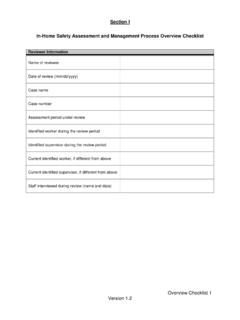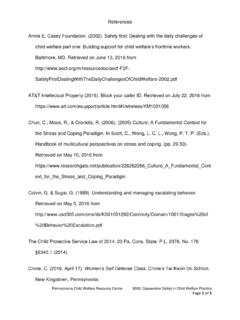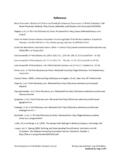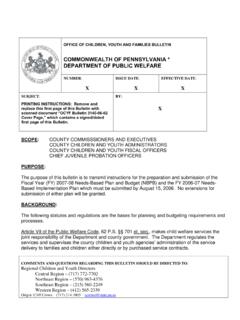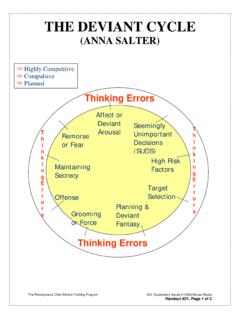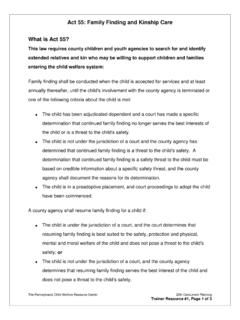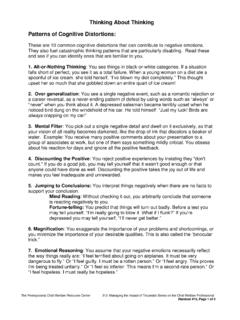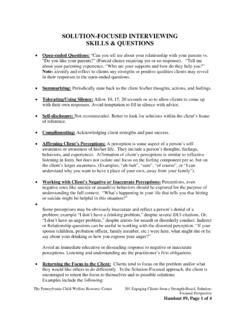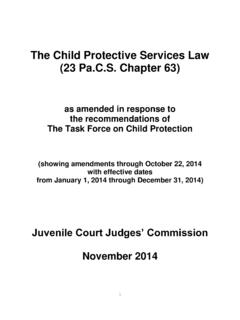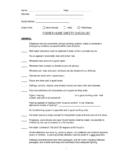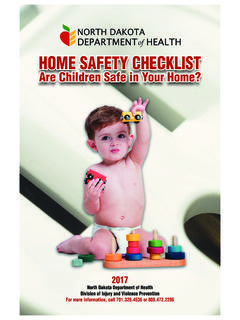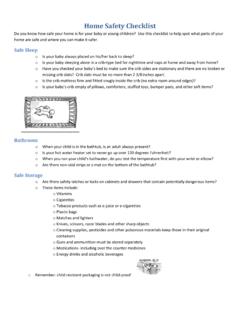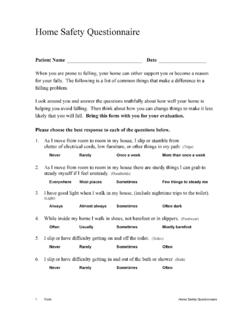Transcription of The Safety Assessment and Management Process Reference …
1 The Safety Assessment and Management Process Reference Manual November 27, 2012 The Safety Assessment and Management Process Reference Manual Page 2 of 161 Rev. 11/27/2012 Table of Contents TABLE OF CONTENTS .. 2 INTRODUCTION .. 3 PURPOSE AND DISCUSSION .. 4 THE RELATIONSHIP BETWEEN Safety AND RISK .. 5 INFORMATION GATHERING .. 7 SIX (6) Assessment DOMAINS .. 8 SECTION I. IN- home Safety Assessment AND Management .. 14 IN- home Safety Assessment DEFINITIONS .. 14 IN- home POLICY .. 17 DOCUMENTATION FOR IN- home Safety ASSESSMENTS .. 24 PRESENT DANGER VS. IMPENDING DANGER Safety THREATS .. 27 Safety THRESHOLD .. 31 PENNSYLVANIA IN- home Safety THREATS .. 32 PROTECTIVE CAPACITY .. 46 Safety ANALYSIS .. 56 IN- home Safety DECISIONS .. 62 Safety Assessment WORKSHEET IN- home .. 64 INSTRUCTIONS FOR COMPLETION OF THE IN- home Safety Assessment WORKSHEET .. 66 Safety PLAN .. 86 INSTRUCTIONS FOR COMPLETING THE Safety PLAN.
2 88 SECTION II. OUT-OF- home CARE Safety Assessment AND Management .. 90 OUT-OF- home CARE DEFINITIONS .. 90 OUT-OF- home CARE POLICY .. 93 ASSESSING FOR PRESENT DANGER .. 97 OUT-OF- home CARE Safety INDICATORS .. 106 OUT-OF- home CARE Safety ANALYSIS .. 114 OUT-OF- home CARE Safety DECISIONS .. 117 OUT-OF- home CARE Safety Assessment WORKSHEET .. 118 OUT-OF- home CARE Safety Assessment WORKSHEET INSTRUCTIONS .. 120 COMMUNICATING Safety CONCERNS .. 123 SECTION III. CASEWORK Process .. 126 SECTION IV. SUPERVISORY ROLE AND RESPONSIBILITIES .. 141 SUPERVISOR CHECKLIST .. 147 BIBLIOGRAPHY .. 148 APPENDIX #1: PRESENT DANGER Assessment : OUT-OF- home CARE SETTINGS WORKSHEET .. 150 APPENDIX #2: OUT-OF- home CARE PRESENT DANGER CONCERNS AND THE SIX Assessment DOMAINS .. 153 APPENDIX #3: Safety IN OUT-OF- home CARE: ALERT TO AFFILIATED COUNTIES .. 157 The Safety Assessment and Management Process Reference Manual Page 3 of 161 Rev.
3 11/27/2012 Introduction The Adoption and Safe Families Act (ASFA) was signed and became federal law on November 19, 1997. This law is tied to federal Title IV-B and Title IV-E funding, building on and amending the Adoption Assistance and Child Welfare Act of 1980. ASFA refocuses requirements to the issues of child Safety , permanence, and well-being. In addition to ASFA, the Administration for Children and Families has focused greater attention toward improving outcomes for children and families involved with the child welfare system by developing specific outcome measures and indicators. Through the Child and Family Services Review, progress toward improving outcomes is assessed, evaluated, and monitored. Specifically, there are two outcome measures that address child Safety : Safety Outcome 1: Children are, first and foremost, protected from abuse and neglect; and Safety Outcome 2: Children are safely maintained in their homes whenever possible and appropriate.
4 Safety Outcome 1 speaks to assuring that investigations are conducted in a timely manner and preventing children from becoming victims of repeat maltreatment. Safety Outcome 2 speaks to determining if services were provided to the family to protect the child in the home and to prevent entry into foster care or re-entry after reunification. Safety Outcome 2 also speaks to assessing risk and Safety concerns relating to the child in their own home or while in foster care. In addition to the two CFSR Safety outcome measures described above, Safety is also a component of the outcome measures that address permanency and well-being for children: Permanency Outcome 1: Children and youth have permanency and stability in their living situations. Well-Being Outcome 1: Families have enhanced capacity to provide for their children s needs. Permanency Outcome 1 speaks to establishing timely and appropriate goals for children in out-of- home care, as well as County Children and Youth Agency processes supporting timely achievement of permanency for children.
5 The Out-of- home Care (OOHC) Safety Assessment and Management Process seeks to incorporate the basic tenets of both the Safety and Permanency Outcome Measures. This assures that the Safety of children is assessed based upon their residence and/or contact with the caregiver(s) of origin. It also assures efforts are made to maintain children with their caregiver(s) of origin whenever possible, while assuring that when out-of- home placement is necessary this is done in a manner that assures children are placed in a safe setting, be it a formal or informal arrangement. Additionally, it makes certain that Safety is continually assessed to 1) determine if the Safety Threats that warranted out-of- home care to occur have been mitigated in order for the child to return home with or The Safety Assessment and Management Process Reference Manual Page 4 of 161 Rev. 11/27/2012 without a Safety Plan in place and 2) to assure that the out-of- home setting in which the child is currently residing continues to be a safe home and meets their needs.
6 In addition to these federal Safety and permanency outcomes, Pennsylvania s statutory and regulatory requirements provide the framework for Safety Assessment . Since ASFA went into effect, the Commonwealth of Pennsylvania has worked toward prioritizing the tenets set forth by ASFA with Safety maintaining its paramount status. When Pennsylvania participated in the federal Child and Family Services Review in 2002, Safety was determined to be an area that would benefit from further study and improvement. As a result, the Risk Assessment Task Force reconvened and formed a sub-committee dedicated to conducting a local and national review of Safety Assessment instruments. More recently, the Department of Public Welfare (the Department) requested technical assistance from the National Resource Center on Child Protective Services (NRCCPS) in further refining Pennsylvania s Safety Assessment and Management Process .
7 As a result of this technical assistance, the NRCCPS provided the Department with recommendations that would enhance the Safety Assessment and Management Process . Additional literature, which was developed by Action for Child Protection, Inc. was reviewed, incorporated, and led to the development of the Process and tool that follows. Special thanks go to Emily Hutchinson and Wayne Holder for their knowledge, insight, and assistance. Assistance will continue to be sought from the NRCCPS as future efforts aimed at developing a Process for assessing Safety of youth placed in congregate care setting, as well as older youth in general occur. Purpose and Discussion Purpose The purpose of the Safety Assessment and Management Process is to assure that each child in a family is protected and to enable caregivers to provide protection to the children for whom they are responsible. This manual provides Reference material regarding the Pennsylvania Safety Assessment and Management Process related to the in- home and out-of- home care processes to assist the transfer of knowledge gained from training to actual casework practice.
8 Discussion Safety is the primary and essential focus that informs and guides all decisions made from intake through case closure, including removal and reunification decisions. For the purposes of the In- home Safety Assessment and Management Process , the focus is on identifying Safety Threats, Present and/or Impending Danger, Protective Capacities, and working with caregivers to supplement Protective Capacities through Safety intervention. The Process leads to making informed decisions about Safety planning and implementation of Safety actions that will control identified threats. Safety Assessment and Management is not incident based and is not defined by determining the presence or absence of injuries or incidents. Safety analysis and decision making uses all The Safety Assessment and Management Process Reference Manual Page 5 of 161 Rev. 11/27/2012 available information to conduct a thorough analysis to decide if a Safety Plan is needed and what specific actions are available and accessible to control identified threats.
9 These Safety actions are used to supplement the caregiver s Protective Capacities. The actions implemented may be in- home , out-of- home , or a combination of the two. When Safety actions cannot be put into place to supplement caregivers Protective Capacities and a decision is made that a child must be placed in out-of- home care, then begins the Process established in Section II of this manual. When a child enters out-of- home care, the In- home Safety Assessment Worksheet must still be completed on the caregiver(s) of origin according to the established in- home intervals. This Process assures that the ongoing Assessment of the threats necessitating the child having to enter out-of- home care is conducted and that the child is returned home when the Safety Threats have either been mitigated entirely or done so enough that in- home Safety actions can be put into place that would allow the child to return home with a Safety Plan in place.
10 While continuing to assess Safety using the in- home tool, the out-of- home care tool would also be used in assessing Safety of the child in the out-of- home setting. This will assure that there is an ongoing Assessment of the child s Safety while in the out-of- home setting. Detailed processes have been outlined within Section II of this manual related to assessing Safety in out-of- home care, which includes collaboration with private providers and the role they play in informing Safety of children being served between public and private children and youth agencies. Future efforts related to Safety Assessment will include a case review of children in congregate care settings to make recommendations for the development of a tool that can be used to assess the Safety of children placed in these settings. Future efforts will also include requesting technical assistance from the NRCCPS on assessing the Safety of older youth who are being served by the child welfare system.
